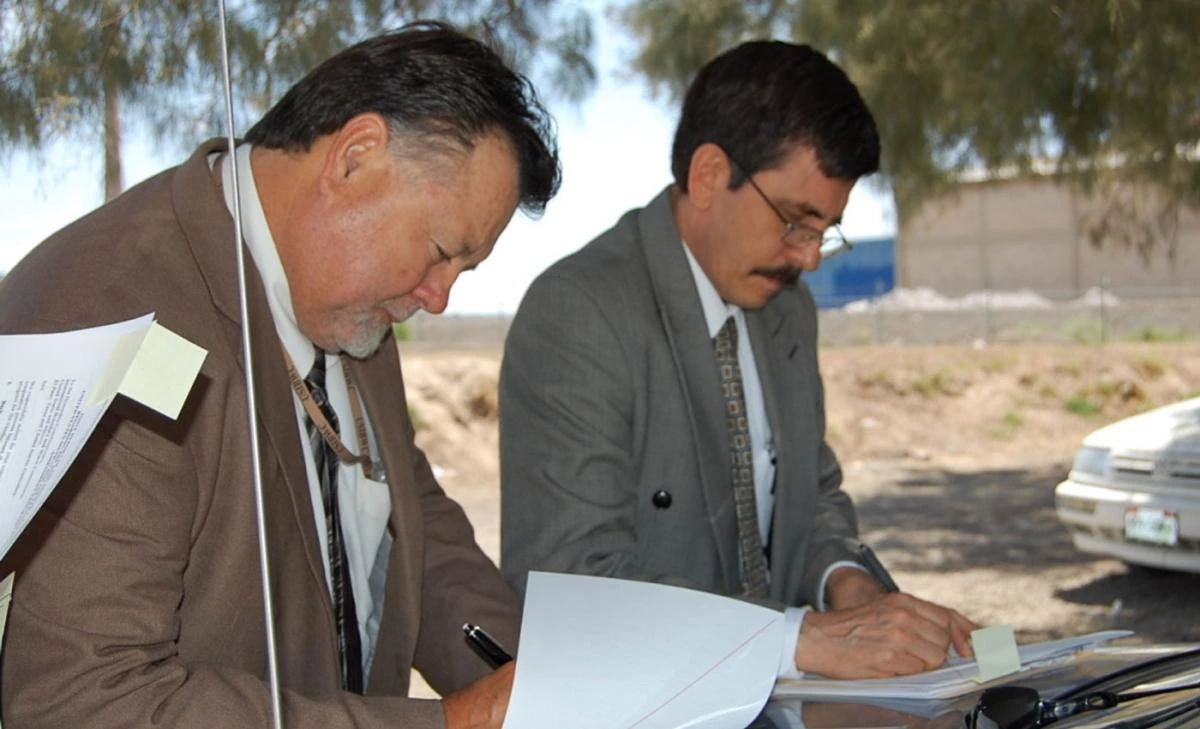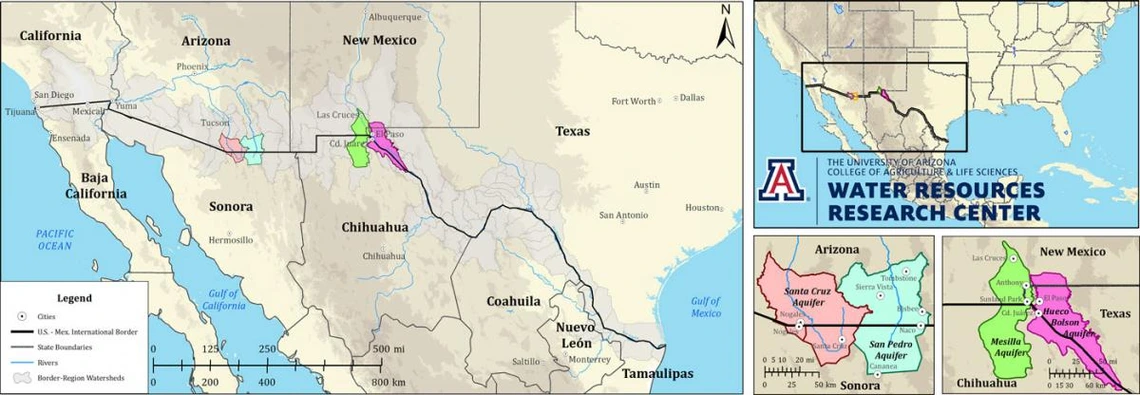
Signing Ceremony at Boundary Monument #1 in El Paso/Juarez. Principal Engineers John Merino and Luis Antonio Rascón Mendoza. August 19, 2009
On August 19, 2009, the Principal Engineers representing the binational International Boundary and Water Commission (IBWC) signed the “Joint Report of the Principal Engineers Regarding the Joint Cooperative Process United States-Mexico for the Transboundary Aquifer Assessment Program” (Joint Report). The Joint Report enabled scientists and government officials from the United States and Mexico to partner in assessing their shared aquifers, an effort that aligns with principles that advance sustainable groundwater management and governance.
Our presentations and other materials on the binational Transboundary Aquifer Assessment Program (TAAP) regularly feature the photo shown here of the signing by IBWC Principal Engineers Luis Antonio Rascón Mendoza of the Mexican section and John Merino of the United States section. Given that the IBWC implements binational solutions to issues arising during application of U.S.-Mexico treaties involving water in the border region, it is fitting that the Joint Report was signed at a mile marker along the U.S.-Mexico border. The three-page Joint Report, my Arizona Water Resource column (Summer 2017) explaining its details and importance, and much more TAAP information can be found on our site. The Joint Report is a concise, well-developed framework for binational cooperation.
I would like to emphasize that TAAP as a binational partnership program began formally in 2009 when the Joint Report was signed. U.S. legislation in 2006 authorized participation by U.S. partners in a program of transboundary aquifer assessment, which established a framework for collaboration involving the U.S. Geological Survey (USGS) and the participating Water Resources Research Institutes authorized by the 1964 Water Resources Research Act as amended. However, the U.S. legislation, P.L. 109-448, could not implement a program involving Mexico; actual implementation of a binational program required cooperation through the IBWC. P.L. 109-448 authorized funding for study of specified priority aquifers through what I assert is a unique partnership between USGS and the Water Resources Research Institutes at New Mexico State University, Texas A&M University, and the University of Arizona. Appropriated funds would be shared equally by the USGS and the water institutes. Although the 2006 legislation authorized $50 million in funding over a 10-year period, a total of $2 million was appropriated for the program through the budgets for federal fiscal years 2008 through 2010. After a drought in U.S. funding, Congress has authorized $1 million for the program annually since federal fiscal year 2016. Mexican funding has likewise depended on decisions of its federal government and has varied over time.
Just as a binational program cannot be established by one country, specifying the binational aquifers for study requires agreement. Four aquifers, shown on the map below, were jointly identified for study. A workshop was held in late 2009 to consider the study priorities along the binational border shared by the states of Arizona, USA and Sonora, MX. Work focusing on these two shared aquifers has been guided by the Joint Report. With IBWC in the key coordinating role, USGS, CONAGUA (Mexico’s national water commission), the University of Arizona, and the University of Sonora have collaborated to produce the fully bilingual 2016 Binational Study of the Transboundary San Pedro Aquifer and the companion study of the transboundary Santa Cruz aquifer, which is still in draft form. Some of the important lessons learned from the binational study of these two groundwater-dependent regions are chronicled in a 2018 article by Callegary et al., “Findings and lessons learned from the assessment of the Mexico-United States transboundary San Pedro and Santa Cruz aquifers: The utility of social science in applied hydrologic research,” Journal of Hydrology: Regional Studies, 60-73. Work has also continued on the two other focal aquifers.
It is hard to believe that 10 years have passed since I had the great pleasure of announcing the approval of the Joint Report at Stockholm’s World Water Week on August 20, 2009, the day immediately following its signature! Ten years later, I remain proud to be participating in this unique binational aquifer assessment program. Because reliance on groundwater is more important than ever, binationally agreed-upon characterization of this critical resource is essential. I look forward to continuing Transboundary Aquifer Assessment Program efforts.


